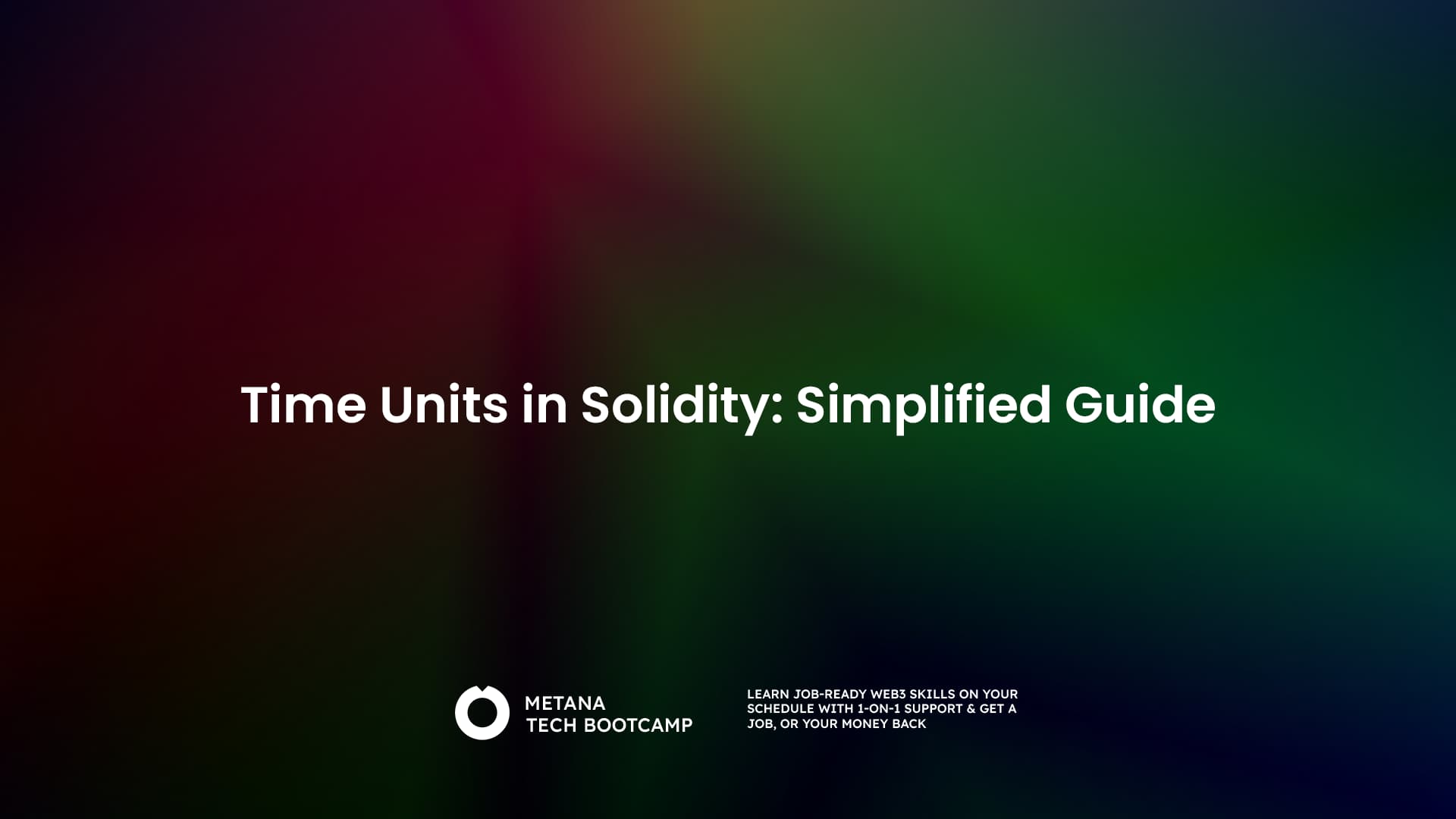Welcome to the fascinating world of smart contracts, where lines of code dictate financial agreements and automate complex processes. But what about time? How do we ensure actions happen at the right moment within a smart contract? This is where Solidity’s time units come in, acting as your trusty timekeeper.
This guide will explain clearly what time units in Solidity are, making them clear and accessible even for those new to smart contract development. We’ll explore what they are, how to use them effectively, and some crucial considerations to keep in mind.
Understanding the Blockchain Clock
Imagine the blockchain as a giant, constantly updating ledger. Each new entry, called a block, comes with a timestamp – a unique identifier indicating the exact moment it was added. This timestamp, measured in seconds since a specific point in history (usually January 1st, 1970), is the foundation of timekeeping in Solidity.
Solidity, the programming language for building smart contracts on the Ethereum blockchain, offers a convenient way to work with time. It provides built-in units like seconds, minutes, hours, days, and weeks that simplify time calculations within your code.
Here’s the key takeaway: these units are essentially shortcuts that translate into a specific number of seconds. For instance, 1 minute in Solidity is equivalent to 60 seconds, and 1 hour translates to 3600 seconds (60 minutes * 60 seconds).
Practical Examples
Now, let’s see these time units in action! Imagine you’re building a smart contract for a crowdfunding campaign. You might want to:
- Set a deadline: You can use 1 days to specify that contributions are only accepted for 24 hours.
- Implement a timelock: Contributions can be withdrawn only after a certain period, for example, 1 weeks after the campaign ends.
- Schedule automatic actions: Distribute collected funds to the project owner after 2 hours of successful funding.
These are just a few examples, but the possibilities are vast. Time units empower you to create time-sensitive functionalities within your smart contracts.

Using Time Units Effectively, The Dos and Don’ts
While time units offer convenience, there are some crucial things to remember.
| Do | Don’t |
|---|---|
| Use integers (whole numbers) like 1 or 2. | Use decimals like 1.5 hours. |
| Remember, these units are just shortcuts (calculations happen in seconds). | Forget that internally Solidity converts them to seconds before performing any calculations. |
| Implement custom logic to handle complexities like leap years (Solidity doesn’t have a built-in unit for months or years). | Rely solely on built-in time units if your logic requires months or years. |
Here are some best practices to ensure your time-based functionalities work as intended:
- Plan your time logic carefully: Before writing code, sketch out the desired timeframes and actions for your smart contract.
- Use comments to explain time-related code: This helps others understand your logic and prevents future confusion.
- Test thoroughly: Time-sensitive functionalities are critical. Use unit tests to simulate different scenarios and ensure your smart contract behaves as expected.
Additional Considerations
While time units are a powerful tool, there are other aspects of time management in Solidity to consider:
- Block time: Blocks on the Ethereum blockchain are added roughly every 13-15 seconds. This means actions within your smart contract might not occur precisely at the specified time unit. Consider this potential delay when designing your logic.
- External Oracles: For highly time-sensitive applications, you might explore external oracles. These are off-chain services that provide data feeds, including timestamps, from the real world to your smart contract.
Understanding these limitations helps you design robust smart contracts that account for potential time discrepancies.
Building Dynamic Smart Contracts
Solidity’s time units equip you to create dynamic smart contracts that react to the passage of time. By mastering these tools and keeping the considerations in mind, you can build functionalities that are both time-aware and reliable. So, the next time you’re crafting a smart contract, remember the power of time units and use them to bring your time-sensitive ideas to life!
Advanced Time Management in Solidity
We’ve established the foundation of timekeeping in Solidity with built-in time units. But what if your smart contract demands even more nuanced time control, or needs to interact with real-world time beyond the blockchain’s clock? This section dives into advanced strategies for managing time in your smart contracts.
External Oracles
Solidity primarily relies on the blockchain’s internal timestamp, which can have slight discrepancies compared to real-world time due to block times. For situations where precise real-world time synchronization is crucial, consider using external oracles.
- What are Oracles? Think of them as bridges between the blockchain and the external world. They fetch data from reliable sources, like time servers, and feed it securely into your smart contract.
- Benefits: Oracles allow you to:
- Access real-world timestamps that are more precise than blockchain timestamps.
- Trigger actions based on specific dates and times (e.g., automatically close an auction at a predetermined real-world time).
- Considerations: While powerful, oracles add complexity. Choose a reputable oracle provider with a proven track record of security and reliability. There might also be associated fees for oracle services.
Custom Time Logic
For specific scenarios where built-in units or oracles might not be ideal, you can implement custom time logic within your smart contract. This involves writing code that tracks and calculates time based on specific conditions.
- Example: Imagine a prediction market smart contract where users bet on the outcome of an event. You could implement custom logic that tracks block timestamps and calculates the time remaining until the event occurs.
- Benefits: Custom logic offers complete control over your timekeeping logic, allowing for tailored solutions.
- Considerations: This approach requires a deeper understanding of Solidity and careful coding practices. Ensure your custom logic is secure and bug-free to avoid unintended consequences.
Decentralized Time Services (DTS)
The world of blockchain is constantly evolving, and Decentralized Time Services (DTS) are an emerging concept with the potential to revolutionize time management in smart contracts.
- What are DTS? Imagine a network of blockchain nodes that work together to maintain a secure and verifiable record of time. This eliminates the need for centralized oracles and provides a more reliable and tamper-proof time source for smart contracts.
- Benefits: DTS can offer:
- Increased trust and transparency in timekeeping mechanisms.
- Potentially lower fees compared to traditional oracles.
- Current Status: DTS is still an emerging concept, and ongoing research is required to solidify its implementation.
While DTS holds promise for the future, currently available tools like external oracles and custom logic offer effective solutions for managing time in your smart contracts.
Choosing the Right Time Management Approach
The best approach for managing time in your smart contract depends on your specific needs and level of complexity. Here’s a quick guide to help you decide:
- For basic time-sensitive functionalities: Solidity’s built-in time units are a great starting point.
- For scenarios requiring precise real-world time: Explore external oracles with a good reputation.
- For highly customized time logic: Consider implementing custom logic if you have the necessary expertise.
- Stay updated: Keep an eye on the development of Decentralized Time Services (DTS) for potential future applications.
Remember, the key is to choose the approach that offers the right balance of functionality, security, and complexity for your unique smart contract.
Conclusion
Time is a powerful element in smart contract development. By understanding Solidity’s time units and exploring advanced strategies like oracles and custom logic, you’re equipped to create smart contracts that react to and leverage the passage of time effectively. Embrace these tools, experiment with different approaches, and build dynamic smart contracts that operate seamlessly within the ever-evolving world of blockchain technology.
FAQs:
What are time units in Solidity?
- Time units in Solidity are predefined keywords like seconds, minutes, hours, days, weeks, and years that help manage time-related functions in smart contracts.
How do you use seconds in Solidity?
- In Solidity, you can use ‘1 seconds’ to represent one second. These units are used for setting time delays or time-based conditions.
Can I use months or years in Solidity?
- Solidity provides ‘years’ as a time unit, but not ‘months’ due to variable days. Use days or weeks instead for more precise time management.
Why is handling time important in Solidity?
- Managing time is crucial for operations like setting deadlines, scheduling events, or time-locking funds within smart contracts.
What are the limitations of using time units in Solidity?
- Time units can be imprecise due to variations in block times, and developers should account for this variability when coding time-dependent functions.
How does block time affect Solidity time units?
- Block time, the interval between new blocks on the blockchain, can vary, causing potential inaccuracy in time-dependent Solidity functions.
What is the ‘now’ keyword in Solidity?
- The ‘now’ keyword in Solidity returns the current block timestamp, which can be used in time calculations within smart contracts.
Can I automate tasks in Solidity using time units?
- Yes, you can automate tasks like releasing funds or triggering events by incorporating time units in your smart contract logic.
How do I avoid time manipulation in Solidity?
- To avoid manipulation, avoid relying solely on timestamps for critical functions and consider using oracles for time-sensitive operations.
What are best practices for using time units in Solidity?
- Use precise time units, account for block time variability, and consider external time sources like oracles for critical time-sensitive functions.








